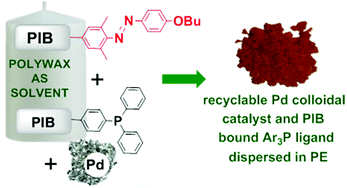Recycling Pd colloidal catalysts using polymeric phosphine ligands and polyethylene as a solvent†
Abstract
Polyisobutylene (PIB)-bound

- This article is part of the themed collection: Green Solvents
* Corresponding authors
a
Department of Chemistry, Texas A&M University, College Station, TX 77842-3012, USA
E-mail:
Bergbreiter@chem.tamu.edu
Tel: +1 (979) 845-3437
Polyisobutylene (PIB)-bound

 Please wait while we load your content...
Something went wrong. Try again?
Please wait while we load your content...
Something went wrong. Try again?
N. Priyadarshani, J. Suriboot and D. E. Bergbreiter, Green Chem., 2013, 15, 1361 DOI: 10.1039/C3GC36932C
To request permission to reproduce material from this article, please go to the Copyright Clearance Center request page.
If you are an author contributing to an RSC publication, you do not need to request permission provided correct acknowledgement is given.
If you are the author of this article, you do not need to request permission to reproduce figures and diagrams provided correct acknowledgement is given. If you want to reproduce the whole article in a third-party publication (excluding your thesis/dissertation for which permission is not required) please go to the Copyright Clearance Center request page.
Read more about how to correctly acknowledge RSC content.
 Fetching data from CrossRef.
Fetching data from CrossRef.
This may take some time to load.
Loading related content
